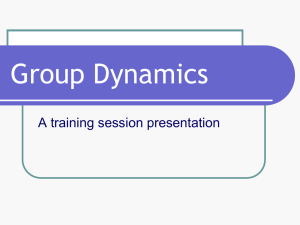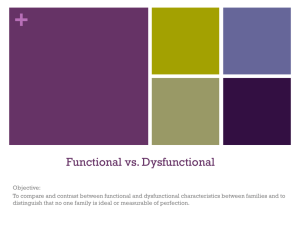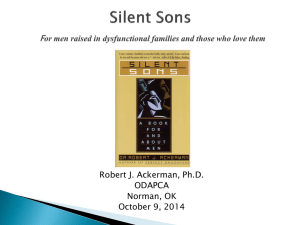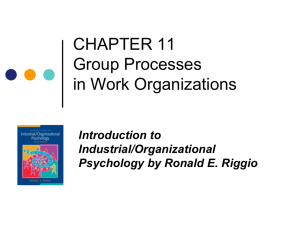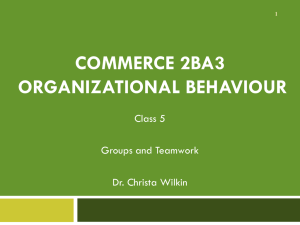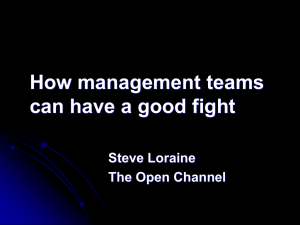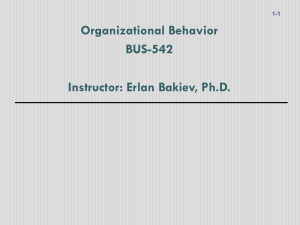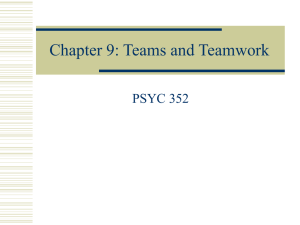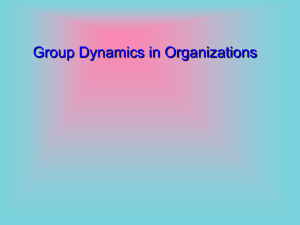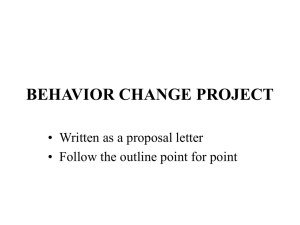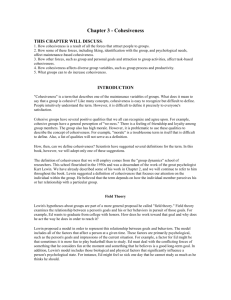Conflict
advertisement
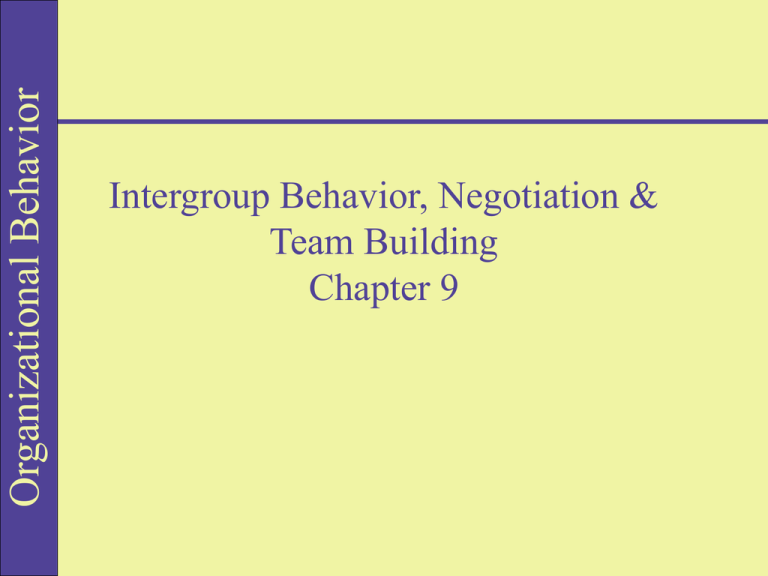
Organizational Behavior Intergroup Behavior, Negotiation & Team Building Chapter 9 Organizational Behavior Group Cohesiveness Definition(s) • Commonness of attitudes or behavior • Greater force holding together than driving apart • Sense of belonging and feelings of morale • Individuals who “are attracted to each other” Note that several of these definitions tend to be circular or confuse cause with effect. Cohesiveness and Performance Cohesiveness is beneficial if the group’s goals are in concert with organizational goals …. Organizational Behavior Sources of Attraction to a Group/Team • • • • • The goals of the group and the members are compatible and clearly specified The group has a charismatic leader The group has a reputation for accomplishment The group is small enough to have members’ opinions heard The members support one another and help each other overcome obstacles Organizational Behavior RELATIONSHIP BETWEEN GROUP COHESIVENESS & AGREEMENT WITH ORGANIZATIONAL GOALS Agreement with organizational goals Low High Low Performance probably oriented away from organizational goals Performance probably oriented toward achievement of organizational goals High Performance oriented away from organizational goals Performance oriented toward achievement of organizational goals Degree of group cohesiveness Organizational Behavior Steps Managers Can Take To Enhance the Two Types of Group Cohesiveness • Socio-Emotional Cohesivness – Keep the group relatively small – Strive for a favorable public image to increase the status and prestige of belonging – Encourage interaction and cooperation – Emphasize members’ common characteristics and interests – Point out environmental threats (e.g., competitor’s achievements to rally the group) Organizational Behavior Steps Managers Can Take To Enhance the Two Types of Group Cohesiveness (continued) • Instrumental Cohesivness – Regularly update and clarify the group’s goal(s) – Give every group member a vital “piece of the action” – Channel each group member’s special talents toward the common goal(s) – Recognize and equitably reinforce every member’s contributions – Frequently remind group members they need each other to get the job done Organizational Behavior Trust Trust: “Reciprocal faith in others’ intentions and behavior.” Propensity to trust: “A personality trait involving one’s general willingness to trust others.” • How to Build Trust – Communication (keep everyone informed; give feedback; tell the truth) – Support (be available and approachable) – Respect (delegate; be an active listener) – Fairness (give credit where due; objectively evaluate performance) – Predictability (be consistent; keep your promises) – Competence (demonstrate good business sense and professionalism) Organizational Behavior Interpersonal Trust Involves a Cognitive Leap Cognitive leap Faith in the other person’s good intentions Assumption that other person will behave as desired Firsthand knowledge of other person’s reliability and integrity Distrust Trust Organizational Behavior Basic Distinctions Among Quality Circles, Virtual Teams and Self-Managed Teams Quality Circles Type of team Type of empowerment Members Advice Consultation Production/service personnel Virtual Teams Advice or project (usually project) Consultation, participation, or delegation Managers and technical specialists Self-Managed Teams Production, project, or action Delegation Production/service, technical specialists Organizational Behavior Basic Distinctions Among Quality Circles, Virtual Teams and Self-Managed Teams (continued) Basis of membership Relationship to organization Amount of faceto-face communication Quality Circles Virtual Teams Self-Managed Teams Voluntary Assigned (some voluntary) Assigned Parallel Parallel or integrated Integrated Periodic to none Varies, depending on use of information technology Strictly faceto-face Organizational Behavior Survey Evidence: What Self-Managing Teams Manage Percentage of Companies Saying Their Self-Managing Teams Perform These Traditional Management Functions by Themselves. Schedule work assignments Work with outside customers Conduct training Set production goals/quotas Work with suppliers/vendors Purchase equipment/services Develop budgets Do performance appraisals Hire co-workers Fire co-workers 67% 67 59 56 44 43 39 36 33 14 Organizational Behavior Characteristics of an Effective Team • • • • • • • • • • • • Clear purpose Informality Participation Listening Civilized disagreement Consensus decisions Open communication Clear roles and work assignments Shared leadership External relations Style diversity Self-assessment Organizational Behavior Eight Attributes of High-Performance Teams: • Participative leadership. Creating an interdependency by empowering, freeing up, and serving others • Shared responsibility. Establishing an environment in which all team members feel as responsible as the manager for the performance of the work unit • Aligned on purpose. Having a sense of common purpose about why the team exists and the function it serves • High communication. Creating a climate of trust and open, honest communication • Future focused. Seeing change as an opportunity for growth • Focused on task. Keeping meetings focused on results • Creative talents. Applying individual talents and creativity • Rapid response. Identifying and acting on opportunities Organizational Behavior Why Work Teams Fail Mistakes typically made by management Teams cannot overcome weak strategies and poor business practices Hostile environment for teams (command-and-control culture; competitive/individual reward plans; management resistance) Teams adopted as a fad, a quick-fix; no long-term commitment Lessons from one team not transferred to others (limited experimentation with teams) Vague or conflicting team assignments Inadequate team skills training Poor staffing of teams Lack of trust Organizational Behavior Why Work Teams Fail Problems typically experienced by team members Team tries to do too much too soon Conflict over differences in personal work styles (and/or personality conflicts) Too much emphasis on results, not enough on team processes and group dynamics Unanticipated obstacle causes team to give up Resistance to doing things differently Poor interpersonal skills (aggressive rather than assertive communication, destructive conflict, win-lose negotiation) Poor interpersonal chemistry (loners, dominators, self-appointed experts do not fit in) Lack of trust Organizational Behavior Conflict Conflict: “A process in which one party perceives that its interests are being opposed or negatively affected by another party.” Functional conflict serves the organization’s interests while dysfunctional conflict threatens the organization’s interests. Organizational Behavior The Relationship between Conflict Intensity and Outcomes Positive Neutral Too little Negative conflict Low Appropriate conflict Moderate Intensity Too much conflict High Source: LD Brown, Managing Conflict of Organizational Interfaces, © 1986, Addison-Wesley Publishing Co., Inc., Reading, Massachusetts. Figure 1.1 on page 8. Organizational Behavior Why do we try to eliminate conflict? • Ingrained – reinforced at home, school, church • Managers are often evaluated and rewarded for lack of conflict – part of the culture of the organization • Avoid disturbing the status quo “If it isn’t broke”… do you break it or move on? Organizational Behavior Antecedents of Conflict • • • • • • • Incompatible personalities or value systems. Overlapping or unclear job boundaries. Competition for limited resources. Interdepartment/intergroup competition. Differences in perceptions or inaccurate perceptions Inadequate communication. Functional differences – line and staff; production & marketing • Interdependent tasks. • Organizational complexity. Organizational Behavior Antecedents of Conflict (continued) • Unreasonable or unclear policies, standards, or rules. • Unreasonable deadlines or extreme time pressure. • Collective decision making. • Decision making by consensus. • Unmet expectations. • Unresolved or suppressed conflict. Organizational Behavior Conflict Outcomes • Agreement: Strive for equitable and fair agreements that last. Search for solutions (Functional consequence) • Stronger relationships: Build bridges of cohesiveness, goodwill and trust for the future. (Functional consequence) • Learning: Greater self-awareness and creative problem solving. Change and adapt. (Functional consequence) • Focus on activity: become task oriented; less concern for individual satisfaction – defeat the enemy. (Dysfunctional consequence) • Develop loyalty – conformance to norms tends to become important in conflict situations. (Dysfunctional consequence) Organizational Behavior Conflict Outcomes • Distorted perceptions: members may develop stronger opinions of the importance of their unit. Survival of the fittest. (Dysfunctional consequence) • Negative stereotyping: as conflict rises, stereotypes are reinforced. See fewer distances in your group and greater differences between groups than really exist. (Dysfunctional consequence) • Decreased communication: decision-making process can be disrupted. (Dysfunctional consequence) • Also – violence and aggression. (Dysfunctional consequence) Organizational Behavior An Updated Contact Model for Minimizing Intergroup Conflict Level of perceived intergroup conflict tends to increase when: • Conflict within the group is high • There are negative interactions between groups (or between members of those groups) • Influential third-party gossip about other group is negative Recommended actions: • Work to eliminate specific negative interactions between groups (and members). • Conduct team building to reduce intragroup conflict and prepare employees for cross-functional teamwork. • Encourage personal friendships and good working relationships across groups and departments. • Foster positive attitudes toward members of other groups (empathy, compassion, sympathy). • Avoid or neutralize negative gossip across groups or departments. Organizational Behavior Ways to Build Cross-Cultural Relationships Behavior Be a good listener Be sensitive to the needs of others Be cooperative, rather than overly competitive Advocate inclusive (participative) leadership Compromise rather than dominate Build rapport through conversations Be compassionate and understanding Avoid conflict by emphasizing harmony Nurture others (develop and mentor) Rank 1 2 Tie 2 3 4 5 6 7 8 Organizational Behavior Managing Intergroup Conflict through Resolution • Problem-solving: reduce tensions through face-to-face meetings of conflicting groups. Identify conflicts and resolve them. Involves identifying all issues, debates, and decision-making. • Superordinate goals: develop a common set of goals and objectives that can’t be obtained without the cooperation of groups involved. • Resources: Try to expand resource if the source of conflict is limited resources • Avoidance: effective only in short-term. Does not resolve or eliminate conflict – eventually it must be faced. • Smoothing: emphasize the common interest of the conflicting groups and de-emphasize their differences. Manager does not take sides – may only be a short-term solution. Organizational Behavior Managing Intergroup Conflict through Resolution • Compromise: No distinct winner or loser – not an ideal situation for either group. • Authoritative command: management steps in and expresses desires to groups. Subs usually follow; whether or not they agree with it. Again, short-run solution. • Altering the human variable: changing human behavior • Altering structural variables: change the formal structure of the group. Changing members, identify a coordinator. • Identifying a common enemy: groups in conflict may unit to defeat a common enemy. Concern for Others Organizational Behavior Five Conflict-Handling Styles High Integrating Obliging Compromising Low Dominating Avoiding High Low Concern for Self Source: MA Rahim, “A Strategy for Managing Conflict in Complex Organizations, Human Relations, January 1985, p 84. Used with author’s permission. Organizational Behavior Alternative Dispute Resolution (ADR) Techniques • Facilitation: Third party gets disputants to deal directly and constructively with each other. • Conciliation: Neutral third party acts as communication link between disputants. • Peer review: Impartial co-workers hear both sides and render decision that may or may not be binding. • Ombudsman: Respected and trusted member of the organization hears grievances confidentially. • Mediation: Trained third-party guides disputants toward their own solution. • Arbitration: Neutral third-party hears both sides in a court-like setting and renders a binding decision. Organizational Behavior Group Negotiations • “A give-and-take decision-making process involving interdependent parties with different preferences.” • Only successful negotiations have all parties walking away feeling like they have won. Managers can: – Understand the other side. Identify all needs and positions of the other group(s). Must ask questions. Attempt free exchange of information. – Know all options: develop, understand, and evaluate options to resolve the conflict. Outcomes may differ if issue is renegotiated. Organizational Behavior Questionable/Unethical Tactics in Negotiation Lies Puffery Deception Weakening the opponent Strengthening one’s own position Nondisclosure Information exploitation Change of mind Distraction Maximization Organizational Behavior Negotiation Tactics • Good cop/bad cop • Nibble: receiving an additional concession after an agreement has been reached. • Joint problem solving: what can be done so that both sides win? • Power of competition: outsource the group (or put the fear of that on the table) • Splitting the difference: useful if groups are at an impasse • Low-balling: lower other groups expectations
